Abstract
This study focuses on the use of green energy technologies in today’s cities. The benefits of green energy will be studied in depth and an understanding of how green energy is produced will be acquired. The study will carry out a case study oon Masdar city, a planned city located in Abu Dhabi that runs on clean energy. The planned city is expected to be carbon neutral once in operation. The study focuses on the construction processes of the Masdar and the expected outcomes of the project. Green energy resources will be assessed in detail with their operational and technical features highlighted. From the study an understanding of what sustainable cities are will be gained.
Introduction
Background of the problem
Pollution is a major problem in today’s world. The 20th century has proved that for man to continue enjoying the fruits that nature has in store for him he has to take care of his environment. Due to industrialization and the advancement in technology man has developed complex machinery and equipment that make it possible to do what was impossible in the past. This has been accompanied by an addiction for fossil fuels that account for majority of the earth’s pollution (Doeden, 2010).
Air pollution is the most serious of all types of pollution. It can be scientifically defined as the introduction of foreign elements into the earth’s atmosphere and results in the damage of animal and plant life. The air in urban areas was found to be the most polluted as at 2008. This was caused by emissions from industries and motor vehicles (Gabriel, 2008).
In the recent years major world economies have held talks so as to map out plans on how to reduce the global carbon emissions. This has resulted in a slight reduction of carbon emissions per year on a global scale. However, the need for a permanent solution to the carbon emission problem has never been this urgent as the earth is on a constant degradation trend due to the high carbon concentrations in the atmosphere. There are two types of harmful carbon compounds namely carbon dioxide and carbon monoxide. Carbon dioxide is a result of combustion and respiration of animals while carbon monoxide is a result of combustion in insufficient oxygen levels. These two compounds are both harmful to the environment when they exist in the atmosphere at high levels (Kibert, 2008).
The high carbon concentrations that exist today are a result of many years of man’s negligence. Coal and oil are the number one contributors of carbon problems in the world. Before their discovery man had problems with finding a reliable energy source. Coal and oil were later discovered and they proved to be cheap energy sources that were abundant in supply. Records show that carbon emissions have increased by 30% since 1750; pre-industrial era. It is due to over a century of their exploitation and their ever increasing dependence that the world is currently facing carbon concentration problems.

Carbon has many effects on the earth. A notable effect is the greenhouse effect. The greenhouse effect has resulted in (Mirchandani, 2010):
- A shift and change in rainfall patterns all over the world
- Rise in ocean / sea levels
- Resulted in an aggression of nature against man in the form of tsunamis, floods etc
- Melting of snow caps
- Displacement of animals and the extinction of species for example bears in the North Pole
- Increase in global temperatures
Carbon is known as a greenhouse gas due to its tendency to induce the greenhouse effect on the earth. The greenhouse effect works on the principle that carbon dioxide when produced on the earth’s atmosphere rises to higher levels of the atmosphere. When the sun’s rays penetrate the earth they heat and warm the earth. But not all rays are absorbed by the earth’s surface and some rays are reflected back into the atmosphere. These rays are meant to pass through the atmosphere and go back into space. However, since carbon dioxide is a greenhouse gas it traps some radiation and re-emits the radiation back into earth. This results in an accumulation of trapped radiation in the earth’s atmosphere and results in a gradual increase in the earth’s temperature. It is due to these atmospheric temperature changes that physical changes occur on the earth i.e. melting of snow caps, increase in sea levels, natural calamities etc.
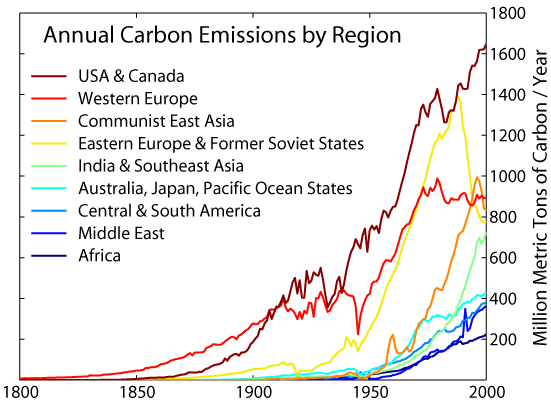
To ease these problems many scientists have come up with alternative forms of energy such as solar and nuclear energy. Most economies are yet to fully implement these green energy sources as they are still relatively new. However a notable booster to the use of green energy has been the global carbon credit program. This has proven as an incentive to many economies to implement the use of green energy. The regeneration of forest cover is a natural alleviation to the carbon emission problem as plants have the ability to absorb carbon from the atmosphere. Another solution is artificially induced carbon absorption by the use of atmospheric carbon as fuel. This technique is still not widely used. A major example of where carbon energy is used is in Masdar City (Gabriel, 2008).
Masdar City is located in Abu Dhabu; United Arab Emirates. The Masdar is a planned city that is to run on green energy. Architectural pans for the city were made by the Foster company of Britain and is sponsored by the Abu Dhabi Future Energy Company. The city is currently under construction and is expected to cost over 20 million American dollars to construct. Masdar is expected to host 50,000 habitants once it is gates are opened. The city is expected to host businesses and merchants dealing in green energy products. A university that will specialize on green energy technologies is also planned.
The Masdar project has been greatly assisted by the generous contributions of sponsors from various sectors. The Abu Dhabi government has rendered great support to the project by providing it with necessary financial and infrastructural support. Corporate partners in the project who are trying to fulfill their corporate social responsibility through the project are Siemens, Credit Suisse and the Consensus Business Group (Jones, 2009).
Planners of Masdar city want it to be a place where businessmen and innovators on clean energy will meet and share ideas on their inventions. This will aid in the exchange and refinement of green energy technologies. In Masdar green energy is expected to be a lifestyle and the residents are expected to live and exist in their own inventions. Masdar will be city of the future in the present. The City is expected to greatly cut down the related costs to technology development as it will act as a central point for green energy development where materials and information will be easily available. Since many researchers, scientists and inventors are expected to live in one place there is going to be an exchange and a complementing effect of technologies from different sources. Masdar will be the apex of green energy revolution.
The Masdar project has four sections namely, Masdar Carbon, Masdar City, Masdar Power and Masdar Venture Capital. Masdar Carbon will deal with the generation of new energy sources to reduce carbon emission, Masdar Power will deal with the construction of green energy power generation plants, Masdar City is the planned city and Masdar Venture Capital will manage the funds received for the project (Mirchandani, 2010).
Masdar Venture Capital is a managerial unit that is responsible for the appropriation of funds to suitable green energy projects all over the world. This unit is also responsible for the assessment of risks in various green energy projects and for the allocation of funds for each project. However the assessment is based on certain set criteria such as the proposed companies should have good managerial abilities, workable business plan and a green energy product that has the ability to break new ground in its intended sector. The proposed projects should also be related to green energy systems, energy conservation systems, desalinization, water utilization and carbon management. The Masdar venture Capital unit is created to finance activities in Europe, Asia and the United States but has not yet been mandated to venture into Africa and other regions. Under the Masdar Venture Capital there is the Masdar Clean Tech Fund. This fund is a 250 million dollar fund that is geared towards direct investments that: have investments in equity worth 5 to 35 million dollars, will exit in 5 to 6 years, have investment periods of 3 to 4 years and the ability to multiply the investments made by at least 2.5 times (Doeden, 2010).
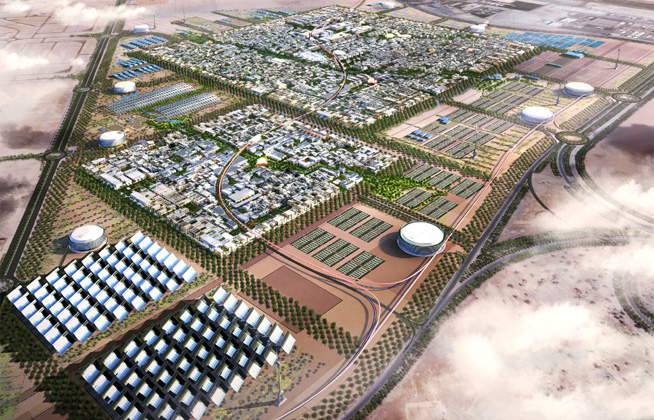
The Masdar project began in 2006 under the umbrella of the Abu Dhabi Future Energy Company whose mandate is to foster global advancement and commercialization of green energy production systems. The project is geared towards the generation of new knowledge on green energy production and the support of these systems so as to form sustainable solutions to global energy problems. The Masdar project in overall is geared towards the production of clean energy solutions that make economical sense and that can be practically employed. Masdar city is expected to cost 22 billion dollars in total. The city is expected to attract potential investors and researchers who will participate in the advancement of green knowledge in Abu Dhabi as well as in the globe. The investments into the project are expected to double once the city is operational and its implementation stages in course. The initial phase of the project is expected to be unveiled late in the year 2010. In summary the Masdar City is expected to be of several benefits namely:
- Promote sustainable urban developments
- Promote international cooperation towards green energy development
- Facilitate the development and promotion of green energy
- Reduce the costs of development and implementation of green energy
- Facilitate the proper testing and refinement of green energy prototypes
- Encourage sustainable green energy solutions
- Provide a suitable business conducting atmosphere for companies dealing in green energy
A global skeleton has been created so as to ensure that the project is sustainable and that it is a success. The support framework for the Masdar project include global institutions and companies that have pledged support for the venture.
This study will focus on the Madsar City. The study will assess the different types of planned green energy projects in the Masdar city. The mode of operation and workings of the projects will be assessed and inferences made thereafter.
Statement of the problem
The need for this study has been brought about by the problem of rising carbon emissions on a global scale. These problems will be addressed throughout the study and solutions / recommendations given. These problems are:
- Rising levels of greenhouse gases in the atmosphere
- High cost of alternative energy
- There is limited knowledge on the green energy sources
- Lack of corporate and political goodwill
- Scepticism on whether the Masdar projects are workable / practical
- The need to identify what makes up a green city
- The need to gain an understanding of the projects that are carried out in a green city
- The need to understand the operations of the projects
Aim of the study
At the end of the study the researcher intends to make some aspects on Masdar City become clear. These are:
- Investigate into the processes, materials and ways of sustainability that have been used in Masdar City.
- To understand how and what makes Masdar city more sustainable than any other claimed sustainable cities.
- To gain an understanding of how and what makes Masdar the world’s first zero carbon and zero waste city.
Justification
This purpose of this study is to generate knowledge on green energy in relation to Masdar City. From the study, information on the Masdar City and the various green energy projects will be reviewed. This information will be used to enable the researchers to make logical analysis of the green energy concepts and assess whether green energy can be applicable to today’s world. The Masdar model will thus be a test subject that can be very valuable in giving a hint of whether green energy technologies can be implemented on a global scale.
The Masdar model will also be used to create an understanding of whether there is potential for planned green energy cities in today’s world. The workings / operational mechanisms of the Masdar models will be used to assess whether these projects are applicable to different settings other than those used in the city.
Research questions
This research aims at answering several questions namely:
- Is Masdar city sustainable?
- In which aspects and ways does Masdar claim to be a sustainable city?
- How is green energy generation done?
- How do photovoltaic arrays work?
- How do solar power plants work?
- How are carbon capture pipeline constructed?
- How do hydrogen fired power generators work?
- In which ways are the Masdar headquarters green?
Literature Review
Sustainable city
Sustainable development refers to the ability of an activity to satisfy the people’s immediate needs as well as maintain the potential to do the same for future generations. This concept tries to understand an ecology’s carrying capacity and ensuring that it is not exceeded so that it can maintain its healthy balance for the future inhabitants.
The sustainable development concept has proposed that there are three important pillars to any ecology namely social, economic and environmental. This concept aims at getting a solution to the conflicts between man and his environment. Man’s existence on the planet has caused much damage to it; the environment has been forced to adapt to these changes often causing harm to man (Tiezzi, 2010).
The Masdar City is envisioned to be a sustainable city where man and environment will exist in harmony. The city’s developments and way of life will be based on the renowned ‘Scheme of Sustainable Technology’. This scheme gives a visual representation of the three pillars of an ecology. This scheme proposes that the environment and society should bear each other, the projects should conserve the environment and at the same time be economically viable, lastly the society and the economy should have an equitable relationship. When the three pillars are well implemented it results in sustainable technology.

In Masdar City various aspects will contribute towards the generation of sustainable energy namely proper utilization of energy resources, proper management of wastes, efficient use of water resources, efficient transport systems and conservation conscious choice of materials. In the sustainable development of the city, the social aspect is well assessed and designed so as to ensure a harmonious existence of all social categories i.e. residential community, corporate community, academic community, leisure seekers and the industrial community. In the economic pillar of the city there must be a balance in the provision of incentives, investment opportunities, government policies and profitability of the ventures. The environmental pillar on the other hand involves the aspect of proper planning of the city, minimization of wastes, energy conservation and efficient transport systems (Masdar Capital, 2010).
The businesses operating in Masdar city are required to accord to the triple bottom line principle. This principle is derived from the ‘Scheme of Sustainable Development’ and requires a business to be profitable, accept that it has a corporate social responsibility towards the environment and conserves the environment it operates in (Doeden, 2010).
The Masdar City is intended to be a global example of a sustainable city. From its success, many other cities in the world are expected to follow its example and implement green technology. The designers’ theme when coming up with Masdar was to create a city of tomorrow in today’s world. The Masdar environment is intended to encourage investors, academicians and inventors to exist in synergy and advance knowledge on green technology. As a result of creating a balance between all the pillars of an ecology the Masdar is expected to have the ‘highest quality of life’
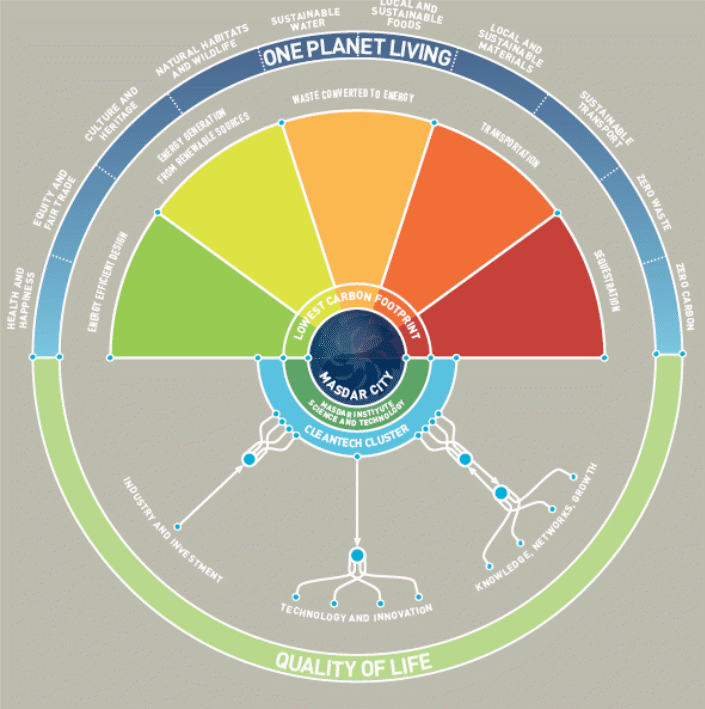
“Masdar City has been able to develop its plan without compromise and to benefit from both historical precedence and technological innovation. It is a sincere aspiration that the lessons learnt in the development, construction and operation of Masdar City will go on to benefit the world.” (Eicker, 2009).
Masdar City planning
The design of the Masdar city is based upon sustainability, aesthetics and the Arabian culture. The project is intended to integrate the Arab culture, modernity and sustainability into one package (Jones, 2009).
In the city’s planning the pathways are well shaded so as to protect the inhabitants from harsh solar glares of the day. These pathways have also been narrowed down so as to provide shading due to the overlapping effect of the buildings. The city will also be oriented in a unique way so as to allow the desert breezes of the night to flow freely within the city. This diagonal direction of the city also allows it to reduce the effects of the day’s hot winds and direct sunlight.
The city’s water and sewerage systems have been well planned so as to flow without the need of heavy pumping and sophisticated equipment. The sewerage and water piping work of the city has been done in a flexible way that allows for the possibility of future expansion of the city. Several storage units have been placed at different points of the city and serve as reservoirs for the city’s population. Treatment plants that are interconnected to the city’s piping will also be installed so as to ensure that water is recycled and that there is minimal wastage (Tiezzi, 2010).
The city will also contain social amenities and sports facilities to provide entertainment for its inhabitants. The city’s plan has given an allowance for a sports utility on the city’s outskirts (Green Energy Republic, 2009).
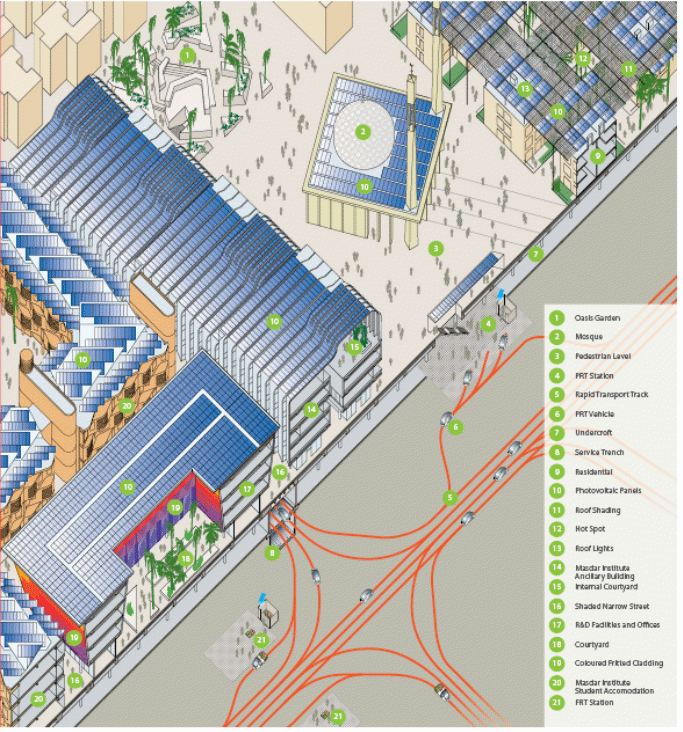
The plan of the city integrates the corporate, social, academic and entertainment communities. This has been done by ensuring a mixed allocation of buildings and offices so as to create an all round society (Cassedy, 2000).
For relaxation the city has gardens and parks for its inhabitants to enjoy. At the heart of the city there is an artificial oasis. This oasis is symbolic to the Arabian culture since ancient Arabs were pastoralists who wandered looking for pasture and water. It is normal for cities and towns to grow from water holes and the oasis serves to represent the ideals and the physical headquarters of Masdar.
A mosque can also be found at the centre of the city. Recycled materials / those with minimal embedded carbon construct the mosque unlike other mosques located around the world (Doeden, 2010).
The Masdar city like other cities of the world will cater for all spheres of human life be it education, entertainment, work etc. The city’s plan has ensured that Masdar will be a complete city with all the social amenities needed for healthy human life while maintaining zero carbon emissions.
Masdar City Centre
At the heart of Masdar city is the Masdar Hotel and conference centre. The designs for this centre have been made by the Laboratory for Visionary Architecture. The designers envisioned a green energy city centre that made good use of the solar rays and heat of the day to power the centre continuously. The Masdar centre is intended to be an example to the globe on the diverse possibilities of sustainable energy technology (Jones, 2009).
This centre will also be an entertainment spot that will contain an arcade, hotels, a relaxation park and walking room. In the middle of the centre, there will be giant ‘mushrooms’ that will provide shade to the centre. These mushrooms are mechanically operated and they tend to follow the sun’s rays as they provide shade to the centre. These mushrooms are operated by programmed drive systems that facilitate them to move in search of direct sun rays. This movement is beneficial as it allows the mushrooms to tap as much solar energy as possible so as to provide heating for the centre at night.
Several energy conservation measures have been taken so as to ensure that the Masdar City Centre is as energy efficient as possible. These include (Tiezzi, 2010):
- Construction of facade angles that are useful in the optimization of solar glare
- The materials that are used in wall construction respond to temperature changes and do not have high amounts of energy that is embedded
- The water features are dormant during the day and are stored underground. These features appear at night and contain sensors that are triggered by human motion.
- Lighting of the city will not be on a continuous basis but will only be switched on when triggered by human heat or mobile phone radiation. This will save on energy that is wasted on illuminating unused areas.
- Surfaces that are radiant in nature
Another unique feature of the Masdar city is its roof gardens that will serve as parks for the city’s population. The temperatures of the gardens will be artificially maintained at the optimum values that are suitable for each type of plant. Due to the artificially maintained environment the crops are expected to grow at near abnormal rates and thus make maximum use of every square meter covered by the garden. These roof top gardens will be fed by treated wastewater that is to be extracted from the city’s sewer. This will ensure proper recycling and use of each unit of water in the city. The gardens are to be irrigated by electronically controlled drip lines that will precisely measure the specific amounts fed to each plant. This will allow for proper utilization of the city’s water resources. The garden will be fertilized by natural fertilizers such as manure. Manure for the roof top gardens is to be prepared from organic matter and from the by products of the waste treatment processes. This will ensure a perpetual cycle in which resources are re-used to produce other resources.
The Masdar city centre will be protected from the desert’s scorching sun and this is strategic in maintaining optimum temperatures for the centre. Due to the desert heat the centre will be cooled by air conditioning systems powered by green energy. Artificial winds will be generated by strategically positioned blowers so as to simulate the characteristics of natural wind. The development of this system will be made by computer software that are to make automated calculations on the different wind flow characteristics required. This computer system will also control wind direction and speed at random settings so as to simulate the uncontrollable nature of wind. Strategically placed blowers will be electronically switched on / off and their speeds changed according to the programmed schedule (Green Energy Coalition, 2010).
To provide sufficient cooling of the centre cooling mist will also be used. The centre’s surface will contain mist blowers that are temperature regulated. When the temperatures exceed their optimum, the mist blowers will be activated and will start producing water in mist form. The mist will then collect the heat from the centre’s environs and will extract this heat as it rises up the building and out into the atmosphere. The centre’s slabs will also be cooled by a water cooling system that will run under the centre’s floors. This cooling system will collect heat from the centre’s floor via underground water channels that will facilitate the absorption and ejection of heat from the building. This channel will also be used to heat up the centre and maintain comfortable temperatures when the natural temperatures of the desert fall below comfortable values. Facades around the centre will be sheltered so as to aid in keeping the centre’s temperatures low during the day’s heat. Heat collected during the day will be stored and controllably released during the night. Storage of the heat will be done by the use of hot liquid tanks and state change heat accumulators. Water collected during the day will be used to heat up the tanks and will then absorb heat from the tanks at night (Eicker, 2009).
Transport within the city centre will be done by the use of lifts and elevators powered by solar energy. This solar energy will be provided by photovoltaic arrays that will be mounted on the building’s roof. These arrays will serve to provide majority of the centre’s energy requirements.
Photovoltaic arrays at Masdar City Centre
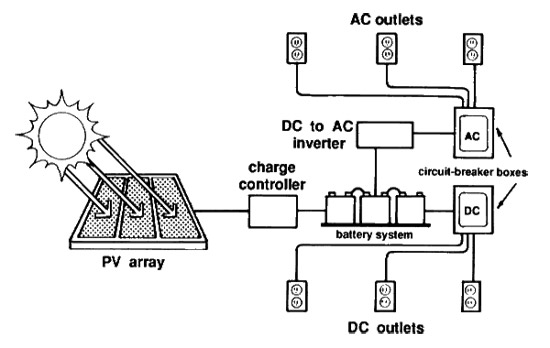
Photovoltaic arrays generate energy based on the principle that when light photons bombard electrons they excite the electrons and elevate these electrons to a higher state energy. When these electrons are excited this results in their movement and eventual flow of electricity. Photovoltaic arrays are made by the use of semi-conductor materials for example; copper sulphide, amorphous silicon, polycrystalline silicon and monocrystalline silicon. The conversion of solar power to electrical is mainly done by photodiodes since they are semiconductors.
The current produced from photovoltaic cells is direct current. This is because the excited electrons flow in one direction unlike from magnetically produced electricity that alternates poles. Because most electronic appliances use alternating current, power generated from photovoltaic cells is usually inverted to form an alternating current (Doeden, 2010).
A glass covering usually protects photovoltaic cells. This aids in the protection of the cells from rain and / or dust. The glass also aids in raising temperatures inside the cell chamber as reflected solar rays are unable to exit the from the cell chamber. This is because glass allows high frequency solar rays to pass through it but is impermeable to low frequency rays. The solar rays penetrate the chamber at high frequencies but when they are reflected by the cells’ surface, they lose their energy and become low frequency rays. In high energy consuming projects such as Masdar a single array is not enough to generate the required power and thus the cells are arranged in interconnected arrays (Lechner, 2008).
Photovoltaic arrays are formed when several solar modules are connected. A photovoltaic module is formed when several cells are connected to each other and are mounted on a support. When these modules are joined together they produce a single output that can be used directly, inverted, amplified or stored in batteries.
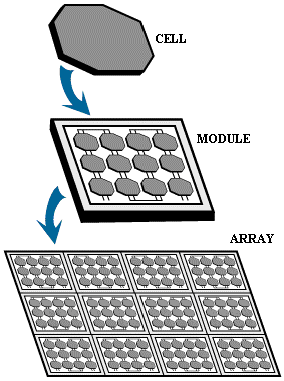
Modern technology such as what is being done in Masdar integrates the use of solar tracking equipment into the photovoltaic arrays. This enables the solar panels to follow the sun from sunrise till sunset. This feature enables an array to maximize the amount of electricity that it can collect since the amount of electricity generated is directly proportional to the amount of incident sunlight. The solar tracker is equipped with light sensors that are able to relate the position of the arrays relative to that of the sun (GLOBE-Net, 2010).
Before setting up a solar photovoltaic system the engineers should assess the power generation abilities of the arrays, the power demand of the centre and the storage mechanism to be used. Photovoltaic arrays have proven to have many advantages over the years namely (Jones, 2009):
- Provide green energy that is pollution free
- Photovoltaic arrays are cheap to install
- Photovoltaic arrays need minimal maintenance so as to remain in operation
- It is economical in respect to the costs incurred and the benefits realized
- Solar energy is generated and used on site and thus eliminates transmission and infrastructure costs
- The cost of research on solar energy is less compared to other sources such as nuclear and fossil fuels
In the design of the city centre the engineers wanted to create a city that would produce more energy than it consumes, utilizes water and energy to highest possible means, reduce its wastes to near zero and cut water consumption by 70% of an ordinary city. This has been enabled by the sophisticated designs of the building that factor in water flow, wind flow, heat flow and distribution.
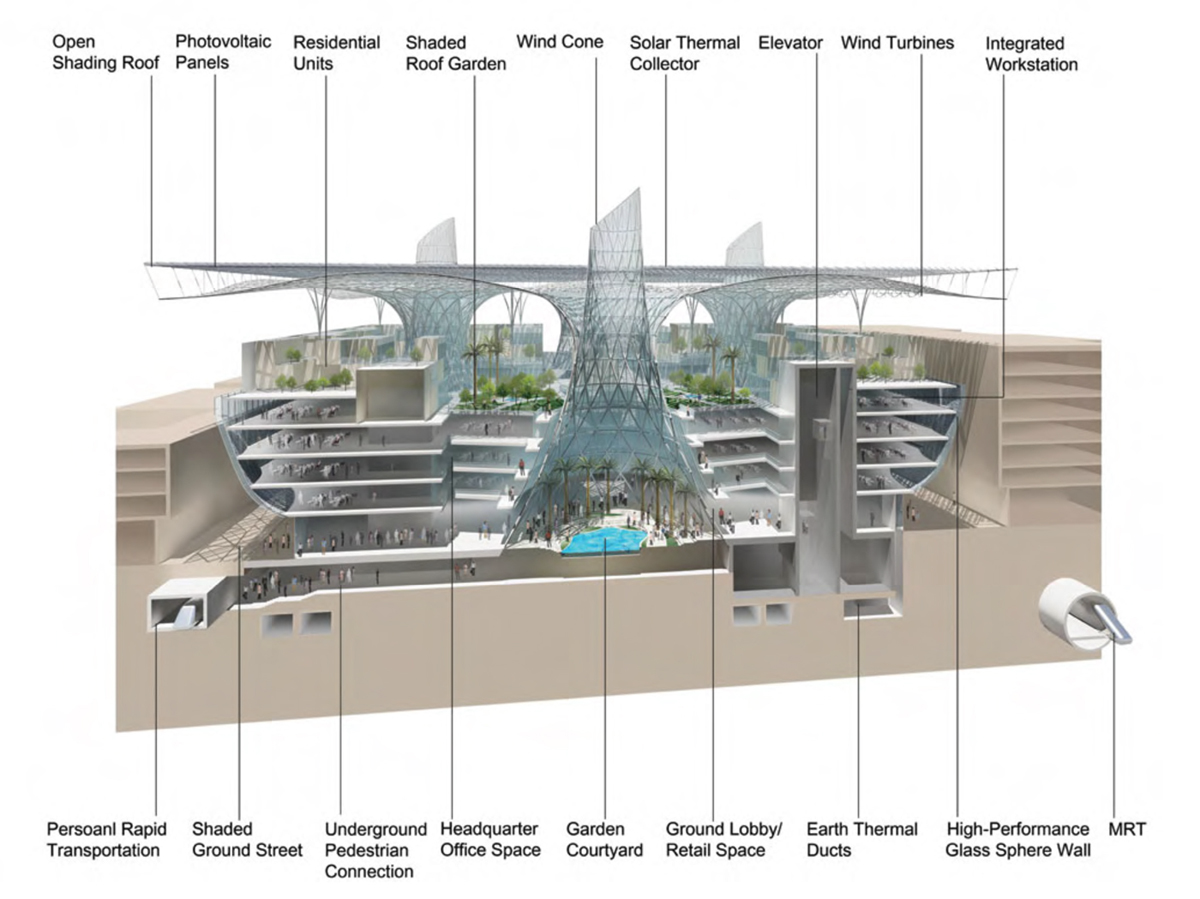
The designers of the city centre borrowed technology from the ancient Arab architecture. This is architecture that allowed for the free flow of air in Arab buildings. This was a natural way of keeping their buildings cool. The Masdar City centre also employs this kind of passive cooling technology. The Masdar City Centre contains wind cones; these are borrowed from the common wind towers that are distinctively evident in most Arab buildings. The cone is meant to capture the buildings hot air and harness it so as to provide ventilation and cooling to the building’s inhabitants. The city centre contains eleven cones in total. Each cone is placed at strategic places in the building’s plan so as to provide even ventilation and air circulation (Eicker, 2009).
The principle behind the cones is; when air is heated up it becomes less dense and rises. The cones therefore capture heated air from the city’s floor and the air rises up the cones and is removed from the building. The removal of air through the cone creates a vacuum and this leads to the entry of fresh and cool air. This is a perpetual cycle that ensures the building is well ventilated at minimal cost. This method unlike fans and blowers does not consume any energy. This is why it is called passive ventilation. Another contributor to the passive ventilation system is the aerodynamic design of the roof during the day. The city centre’s roof has been designed in a way that allows it to manipulate the type of flows that pass over it at any time of the day. The roof designs were made through computational fluid dynamics that allow the designers to change the physical aspects of the building and in turn change the air flow.
During the day the roof acquires an aerodynamic shape that causes a negative pressure to be acquired at the cones. This assists in taking out heated air out of the building and allows cool air to enter. At night the air flow of the building is reversed and the building takes in cool air from the atmosphere and flushes the air down the wind cones to the public areas (Jones, 2009).
To substantially cool the building a large canopy is to be constructed. The canopy is to be 7 acres in size and is responsible for solar power generation as well as lighting of the building. The roof is mounted with photovoltaic arrays that allow for solar energy capture as well as diffusion of light rays into the buildings floors. The building also contains a glass cladding that is designed so as to reduce the buildings heat gaining characteristics while at the same time maintaining proper visibility.
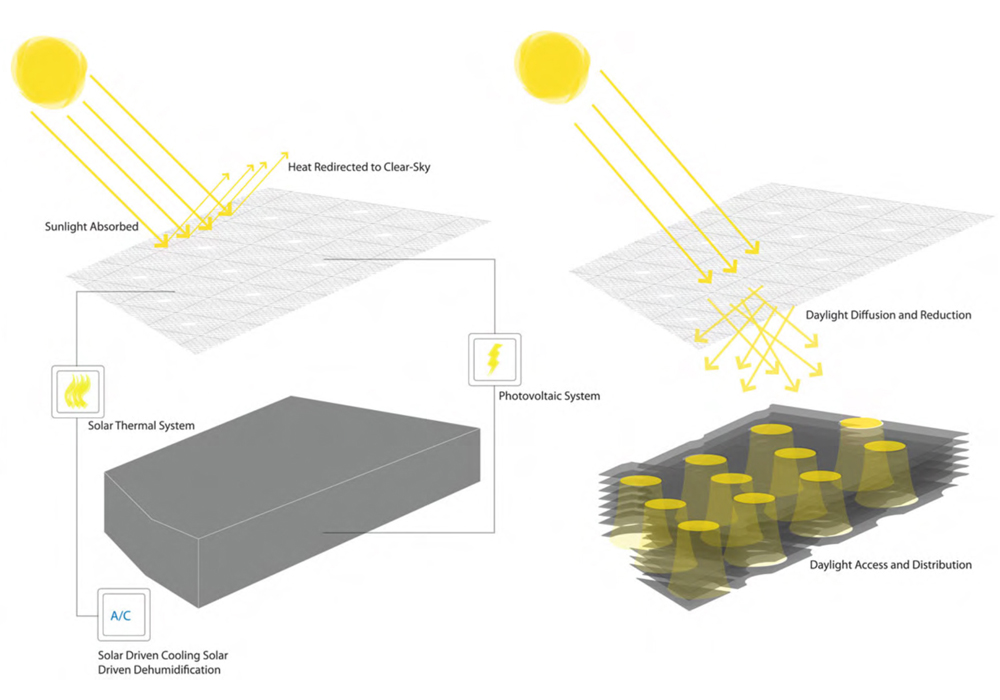
Earth ducts that serve as passage ways and cooling channels have been integrated into the design. These ducts have been constructed at the building’s base and run across it creating a cooling channel for the roof’s floor. The ducts carry the heat and emit it at strategically located vents.
Another passive cooling technique used is in the masonry of the building. In ancient Arab architecture they used thick walls with a high thermal mass to reduce the temperature gains of the building. The Masdar City Centre has also applied this technology and integrated the use of walls with a glazing ratio of 30% and a high thermal mass (Cheyney, 2010).
Active temperature control systems have also been integrated into the building. Such systems involve the use of an energy input in one form or the other into the building. The building applies the use of ground source coolers, underground air distribution networks and a solar powered dehumification and cooling system. The cooling and dehumification system is electrically powered by solar batteries. The batteries are charged when the sun rises and the electrical energy.
The building also generates power from wind turbines. The wind turbines are located at the roof’s top and this serves to collect wind energy from the air that passes along the building’s roof. The winds are therefore used first as an energy source and secondly in a self-cooling mechanism of the structure.
In the United Arab emirates water is a scarce commodity and the need to make the Masdar City Centre water and energy efficient was on the forefront while making the structural designs. Water in the United Arab Emirates is tapped from the sea. The water is then treated and the salts removed. This is usually an expensive and energy intensive operation. It is due to this fact that the Masdar City Centre had to operate at near zero water wastage parameters. The city centre is to collect rain water from its roofs. This water is to be stored in underground tanks until ready for usage. Waste water from the showers and laundries will be used in irrigating the shaded gardens / flushing in the toilets. Water from the toilets; black water, will be converted into bio fuel and eventually contribute to the building’s power grid systems (Lechner, 2008).
In an attempt to make the Masdar energy efficient and green in all forms the choice of materials used when constructing the building were also carefully considered. The building is mainly constructed from recyclable materials sourced at distances of not more than 800 km from the location of the building. This criteria was used so as to minimize pollution and energy wastage as a result of transporting the building materials.
Most furniture was made using recyclable materials that were flexible in nature and recyclable. Embodied energy proportions were also considered in the choice of materials. The material analysis of the city centre revealed that the walls had 22% of embodied CO2, the roof 17% and the floors had 39%. Cost and carbon dioxide payback were also analysed in the planning phases of the city centre to ensure that it will be a global model of energy conservation and green energy technology all over the globe.
The construction processes of the Masdar City centre were also required to be energy conservative in all ways. This was ensured by the proper planning and sequencing of the construction process. For example, the building’s canopy was constructed first so as to serve as shading for the construction team. The mounting of the photovoltaic arrays right from the start of the project was done so as to provide energy for the construction process (Cassedy, 2000).
10 MW solar power plant
A sophisticated solar power plant has been installed in Masdar City. The power plant is expected to generate 10MW of power once its construction is completed. The power plant is the largest solar power generation plant in the Middle East and is to serve as an example to other Middle Eastern countries (Eicker, 2009).
The solar generation plant was constructed by the Enviromena systems that is currently based in the United Arab Emirates. This project is expected to launch Abu Dhabi into fulfilling its 7% green energy pledge by 2020.
This project involved the laying of solar panels on 55 acres of land on the outskirts of Masdar City. The solar collection farm contains a total of 87,777 solar energy production units arranged strategically so as to harness as much insolation from the sun as possible. The yearly output of the power generation farm is expected to be 17,500 MWh. The savings realized from this venture are equal to 15, 000 tonnes of carbon per year; a great contribution to the fight against rising carbon levels in the globe. The constituent materials for the solar panels were 50% thin film and 50% crystalline silicon (Lechner, 2008).
The solar farm was constructed in the initial phases of Masdar’s construction as it is to provide energy for the construction of city. The solar farm was constructed at a cost of 185 million American dollars. During the construction process of the solar farm, green energy technology was implemented in all construction phases, concrete with recycled elements was used and the amount of steel in the construction was reduced. The services of a green energy consultation firm were hired; their mandate being to assess the construction process of the solar power plant and give recommendations on how to cut emissions and reduce the energy requirements of all construction activities.
This solar power plant will be responsible for providing energy to the Masdar Institute of Science and Technology. The Masdar institute of Science and Technology will be located in the Masdar City centre and will be a means in which knowledge on clean energy will be advanced and expanded. This institute will also serve to transform the United Arab Emirates into the world leader in clean energy production. The Massachusetts Institute of Technology partner institution will solely be powered by the Masdar solar energy collection farm.
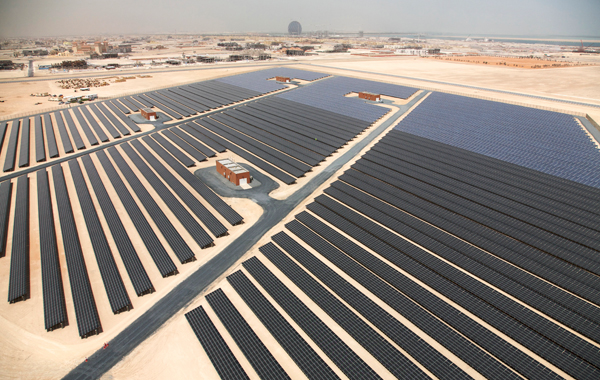
The solar power plant will be connected to Abu Dhabi’s local grid and will sell its surplus energy to the Abu Dhabi Distribution Company. The integration of the solar farm to the Abu Dhabi grid was supervised and inspected by the Emirate Supervision and Regulation body (Doeden, 2010).
One advantage of this project is that the United Arab Emirates receives one of the world’s highest amounts solar radiation and thus has the potential to harness massive quantities of solar energy. The availability of desert land that is clear from shading and obstruction ensures that the panels receive maximum insolation.
A unique maintenance program has been designed so as to ensure that the repair and replacement of the panels in done in a clean and efficient way. The solar farm unlike other types of electricity generation plants will require minimal maintenance and thus savings on energy that would be expended on maintenance activities.
The aesthetic values of the solar farm have been considered in the designs. This has been made to ensure that the farm fits well with the overall appearance of the city. The panels have also been arranged in ways so as to complement the natural air flow patterns of Masdar and thus reduce damages due to strong desert winds. The orientation of the panels has also been made so as to make maximum utility of the sun’s rays as it rises from the east and sets in the west. The maintenance aspect has also been considered in the solar farm and wide passage ways have been provided to allow movement of repair equipment and personnel (Business Wire, 2010).
All solar panels used in the solar farm were sourced from companies that shared Masdar’s goal of green energy utilization. In the bidding process various companies were assessed so as to allow the Masdar officials to choose those companies that had the ability to produce the required quantity of solar panels with the least solar radiation and still create an economical balance.
“This 10MW plant signals a bold step forward in the drive to increase the adoption of alternative energy in the region. It provides the foundation on which the construction of Masdar City will be built, and demonstrates the viability and attractiveness for further PV plants to be built within the region”
The panels which consist of silicon and thin films will be will be interconnected and monitored by an automated system. This system will monitor the energy generation trends of the solar farm and ensure that it is kept in check. The computerized monitoring system will also allow the operators to know the different energy levels produced at different times of the day and at different solar intensities (Cassedy, 2000).
SAM 5C 560 inverters will be used to convert electrical energy from the grid into alternating current that is used by most appliances. After the converters have altered the current, it is supplied to Masdar city or connected to the Abu Dhabi supply lines.
This project has been assessed for viability and has been found to be viable in the long run. The life span of the solar farm is 25 years. This amounts to 375,000 tonnes of saved carbon emissions. From these estimates, it is evident that the solar farm is economically and environmentally viable (Kibert, 2008).
100MW concentrating solar power plant
The Masdar solar concentrator is located in the town Madinat Zayed that is located in the south-western side of Abu Dhabi. This project is being financed by Total and the Abengoa groups that will foresee the project through all its stages up to the implementation phase. The total cost for the initial phase of the project is 350 million American dollars (Eicker, 2009).
The later phases of the concentrator project are planned to increase its power generation capacity from 100 MW to 500MW to supply to Abu Dhabi’s ever increasing need for clean energy. The total area of the concentrator plant will be 2.5 km2. A total of 786 parabolic concentrators will be placed inside the concentrator plant. The Abengoa group in liaison with Masdar have come with the parabola designs (Mirchandani, 2010).
The technology being used in the Masdar project is called the beam down concentrator technology. This technology is an improvement of previous concentrator technologies that used centrally located mirrors which served to concentrate light rays to the edge of a positioned tank. In the old technology the water in the tank was heated to the point of generating superheated steam. This steam was then harnessed and used to drive turbine systems. Unlike its predecessor the beam down technology, uses 48 separate mirrors to channel the solar rays to a tank located on the ground. This new technology is advantageous as it is able to generate higher water temperatures; of up to 500 degrees Celsius.
However, research that was carried out in the development phases of the beam down concentrator recorded slight drops of efficiency compared to the old technology. This has been accounted to the fact that the beam down technology is still new, but researchers are optimistic that with few improvements the beam down could become more efficient than its counterpart.
The solar concentrator at Masdar is expected to generate a total of 100 MW of power to supply to the Abu Dhabi grid for the next 3 years. The Abu Dhabi Water and electricity Supply company has already put in place structural frameworks that are to support the solar concentrator plant once it is put in motion.
The principle behind this technology is, when the sun’s rays are concentrated to a small region the amount of heat and radiation intensity increases. This results in a higher energy level of the rays. This technology concentrates solar rays using mirrors with a parabolic shape and directs the rays to the ground. The mirrors are placed at strategic angles so as to beam their rays to a tank on the ground. The tank is made of special material so as to allow the water inside the tanks to be heated to superheated steam.
From the superheated steam, electricity can be generated by the use of turbines driven by steam. The amount of electricity generated depends on the amount of superheated steam that flows through the blades per unit of time. In the development of this system the amount of steam and expected solar energy must be factored in so as to know the types / size of turbines to be used.
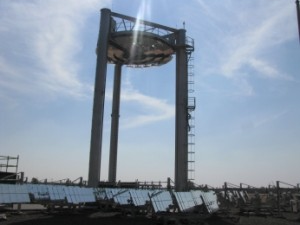
The pioneer studies on the feasibility of this project were carried out by the United Nations environmental Program which deemed this project as highly feasible and beneficial to the world’s environment. The Masdar authorities also asked for technical assistance form the Fitchner group of Germany before the implementation of the project. The Masdar project is being developed at a time when the use of solar concentrators is on the increase. This is because of the gradual drop in solar energy equipment, coupled with low maintenance costs. The required investments for the concentrator plant are the solar concentrator equipment, water tanks, turbines and dynamos for electricity generation, electrical grid and supporting infrastructure. The supporting infrastructure and electrical grid were already in place therefore making the costs for the venture to be reasonably economical (Jones, 2009).
Since the distance between the concentrator plant and Abu Dhabi is reasonably high, the transmission lines will relay high voltage current since this will result in less power losses due the resistance of the power lines. This current will be relayed in direct current unlike the ordinary alternating current transmissions.
Another type technology that will be used in Masdar is the implementation of concentrated solar photovoltaic plants. These plants will involve the concentration of solar energy on photovoltaic cells. This is known to increase the photovoltaic cells’ efficiency and power generation capacity. However several modifications must be made on the cells so as to enable them to sustain the excessive heat from the concentrators. These modifications include, the implementation of active cooling methodologies on the cells so as to dissipate excess heat energy and the use of heat sink mechanisms (Eicker, 2009).
Carbon Dioxide capture power plant
The initial stages of this project were put in motion in the year 2008. The Abu Dhabi Future Energy company invited companies to bid on the construction tenders of the project. The winning company was the Mustang Engineering company of Texas (Cassedy, 2000).
This project involves the construction of facilities that trap carbon dioxide from industries and power plants in the Abu Dahbi area. After the carbon dioxide is trapped it is transported via a pipeline that leads the gas into oil reservoirs in Abu Dhabi. The carbon dioxide is injected into stored oil in the reservoirs and this serves to substitute natural gases that are usually injected into the oil reservoirs.
The initial phase is to consist of a capture of approximately 5 million tonnes of Carbon Dioxide gas. This quantity is to be captured from various sources such as a steel milling plant, an aluminium smelting plant and a gas-fired power plant.
This project is a joint venture between the Abu Dhabi Future Energy Company and the Abu Dhabi National Oil Company. The Abu Dhabi National Oil Company has pledged to purchase all captured carbon that is supplied to its premises (Aqeel, 2010).
The power to be produced from this project will be sold to the Abu Dhabi Water and Electricity Authority for distribution and use around the Abu Dhabi region.
In most industries the produced gases- that are mostly pollutants are usually released into the environment. This project is based on the principle that if you can capture the carbon dioxide produced from industries and find a use for the gas; that would convert it into a less harmful or harmless gas, then such an activity would result in an overall reduction in carbon dioxide emissions into the environment. The scientists in this project have thus found a way of extracting carbon from the industrial emissions by the use of oxygen enrichment processes. This involves the combustion of the emissions in enriched oxygen. The result is that all carbon elements that are present in the emissions will bind with an oxygen molecule to form carbon monoxide in the initial stages of the enrichment process. The carbon monoxide gas is then combusted in surplus oxygen to form carbon dioxide gas (Mirchandani, 2010).
The produced Carbon dioxide is then transported via special vehicles and pipelines to the storage sites. Carbon dioxide gas has several properties that make it suitable for pipeline transport such as, it is colourless, it is odourless, it is non-flammable and can be transported in virtually any physical state. Most pipelines transport carbon dioxide as dense-phase liquid. This makes it easy to pump and to impart flow of the gas in pipelines. For carbon dioxide to exist in such a phase it is passed through compressors that compress the gas beyond its critical point and this results in a change of state of the gas (Cassedy, 2000).
The carbon dioxide is usually purified before transportation. This is because impurities in the gas have an effect on the critical point of the gas and its hydraulic properties that ultimately affect its flow characteristics in the pipelines. Pipeline conditions should always be kept constant as fluctuations in pressure and temperature of the carbon dioxide have a great impact on the cost and life-time of the pipelines. This is because these changes result in unwanted occurrences such as formation of hydrates in the pipelines and embrittlement of the pipelines. In cases where the temperature of the gas has risen in the pipelines an intermittent pump station must be employed so as to ensure that the gas remains in a dense-phase liquid state.
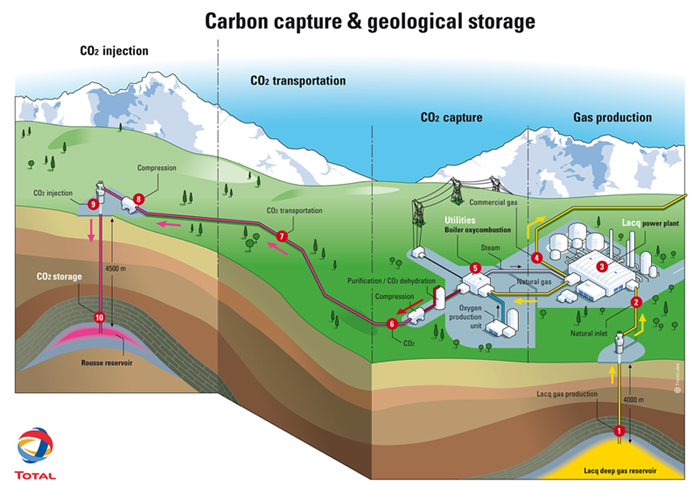
Another aspect of carbon dioxide transportation is the choice of materials; elastomers cannot be used to transport carbon dioxide in pipelines. This is because carbon dioxide in the dense-phase liquid state diffuses into elastomers at certain pressure levels and results in blistering of the elastomers once the pressure is reduced. This in some cases has resulted in explosions due to the drastic changes in compressional forces of the material. It is due to this property that oil pipelines are unsuitable for carbon dioxide transport as they employ the use of elastomers. Pipelines for carbon dioxide flow are also required to exceed the carbon dioxide pipeline fracture limits so as to cater for the decompression properties of carbon dioxide and prevent the fracture of the pipeline (United Nations Environmental Program, 2009). The Abu Dhabi pipeline is a good example of a well modified transport system that is suitable for carbon dioxide transport. The Abu Dhabi carbon dioxide pipeline avoids the use of elastomers as pipeline components and has put in place fracture prevention mechanisms on the pipeline (Gabriel, 2008).
The Abu Dhabi pipeline construction is based on the physical properties of carbon dioxide gas. Factors to be considered in the choice of pipeline materials include (Oxford Business Group, 2009):
- Expected operating pressure
- Intended temperature of operation
- Gas mixture proportions in relation to impurities
- Corrosive characteristics of the gas
- Temperatures of the surrounding environment
- Landscape through which the pipeline traverses
- Risk assessment of the pipeline
The pipelines serve to transport the carbon dioxide to storage points. The carbon dioxide from the Abu Dhabi project will be stored in depleted oil reservoirs, saline aquifers, empty natural gas fields and geological formations. Of all the storage alternatives, geological formations are the most favourable. This is because geological formations have the least risk of damaging the environment. The pipeline is expected to traverse 500 km of desert land to get to the oil fields.
The carbon dioxide is finally injected into oil fields to encourage recovery. This process involves the injection of carbon dioxide gas into depleting oil mines and this is aimed at attempting to replenish the mines and improving their oil yielding capacity (Gabriel, 2008).
Solar powered road and site lighting
The Solar One energy solutions company will be responsible for the provision of lighting services to the Masdar construction stations and roadways. Solar One has established a partnership with the Arabian firm Gargash Lighting Systems and is working closely with them so as to meet its proposed goals. The factor that contributed to Solar One being selected by the Masdar authorities was because of their patented solar lighting that was able to withstand the desert’s sandstorms as well provide steady current even at cloudy weather.
Solar One has integrated its solar lighting technology into the Masdar project; shoebox range for parking lots and road lighting and the canopy range. The company has also made other installations in the Masdar city such as the installation of fixture systems (single and dual) on the Atkins road in the city. The installations made were able to generate up to 15 Lux along the road, its intersections and roundabouts (Jones, 2009).
These lighting systems contain solar panels that are charged during the daytime. Electrical energy is stored in batteries that are used to power the street lighting at night. This ensures that the street lighting can operate independently without the need for an external power source (Gabriel, 2008).
The Solar One lighting systems make use of light emitting diodes to provide the illumination. The light emitting diodes are highly efficient and ensure proper conversion of electricity into light energy with minimal losses. The lights are fitted with advanced optics that ensure that all light rays are directed to pathways and roadways and there is minimal wastage of light; illumination of unused areas. The Solar One street lights have shown good visual uniformity and have been able to provide broad spectrum lighting.
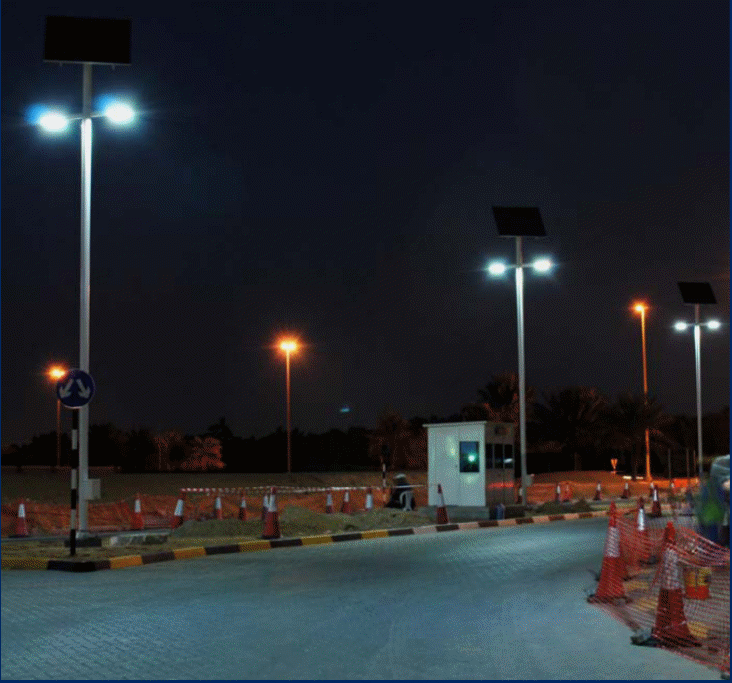
To eliminate the use of protective shielding, light emitting diodes that have a IP65 rating have been used in the project. The number of lumens used by the Solar One system is nearly half of conventional lighting systems resulting in huge energy savings. It is because of this fact that the Solar One systems implement the use of smaller photovoltaic panels and storage batteries compared to other types of solar lighting. The Solar one technology is also designed so as to adapt to the harsh conditions of the desert such as sandstorms and cloudy days that greatly reduce the amount of light that is able to fall on the solar panels.
The initial costs for installing the Solar One systems is higher but has a relatively short payback period. This can be compared to ordinary lighting systems that are cheaper to install but require constant reinvestment of capital so as to offset recurring energy requirements. The Solar One systems once installed are self sustaining and require minimal maintenance. The use of solar lighting has also come with several advantages to Masdar such as the elimination of underground electrical grids and faster installation due to fewer components. Solar lighting is also easier to put into operation as each individual lamp is independent with its own panel and battery unlike grid powered lamps that require the whole grid to be connected before the lighting system is put in place (Smith, 2009).
The Solar One models are also cheaper and more efficient compared to other types of solar lights that are powered by a central grid
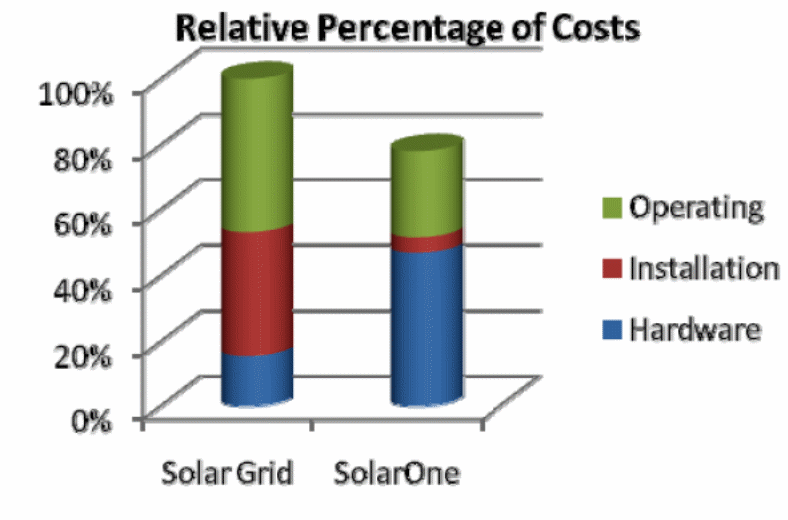
Solar powered transport system
The transport network is an important aspect of any city. How transportation of goods and commodities are done is the true reflector of a people’s culture and way of life. The Masdar designers had the intention of portraying a modern city that implemented the use of clean energy in all its spheres of the day to day lives of its inhabitants. In Masdar there will be zero use of conventional vehicles and prototypes have been developed so as to serve the city. The city will have three types of transportation utilities namely, an aerial railway system, ground level streets for cycling and pedestrian use and an underground transport system that utilizes transport modules (Kibert, 2008).
The ‘Masdar Public Rapid Transport’ system (PRT) consists of unmanned vehicles that have the ability to ferry a maximum of six passengers from one end of the city to the other. The PRTs will be unmanned; will move on programmed pathways and thus will not require to be steered manually. The Passengers of the PRT will be required to enter the details of their next stop in to an inbuilt console once they have entered the pod. The pod will then ferry the passengers to the desired location and automatically stop giving the passengers room to alight. It can then be reprogrammed by another set of passengers and take them to a different location. The PRTs will have the ability to ferry passengers to any of the 1500 stop points in the Masdar city. Coupled with imaging devices and computerized maps the PRT pods will be able to perform effectively and efficiently with minimal failure rates.
The PRTs are expected to serve a huge population of commuters; estimated to be 120, 000 daily, between stops of a minimum of 200 meters. Due to the great responsibilities endowed on the PRTs they have been designed to be durable and tough so that they can be able to resist they wear and tear that results from continuous use. The designers of the PRT so as to reduce the downtime of the vehicles during repair have incorporated an inbuilt self detection system that allows the PRT to self diagnose and identify parts that have malfunctioned. This eliminates the need for maintenance and repair engineers to search for defective parts when making repairs on the PRT (Gabriel, 2008).
The decision by the Masdar authorities has great impacts on the overall quality of life for Masdar residents; the roads will be narrow / more conducive for pedestrians and cyclists and the quality of air in the city will be high due to the elimination of wastes from vehicles. This is attributed to the fact that vehicles are the number one contributor to unclean air in cities and the number one cause of road related accidents.
In an attempt to address the lack of privacy and uncomfortable conditions of many public transport systems the Masdar designers came up with the PRT concept that facilitated the transportation of fewer people in each module. This would create a feel that comes close to the use of personal vehicles and also enables energy savings to be made. The modules save energy since they avoid the wastage of energy such as what happens in trains; they avoid unnecessary energy losses on transport units that are not utilized to capacity i.e. a train that is quarter its capacity still uses the same fuel as a full one (Doeden, 2010).
The PRT pods will be monitored from a central station where proper routes and schedules will be mapped. The control station will also be able to detect faulty modules and make arrangements for their replacement or repair. The control station is also able to program the PRT system in response to commuter traffic so as to avoid congestion in the pick up points. The control station will also allow for a planned dispatching of the modules and thus enable the city to have a smooth flow of traffic that is accident free (Jones, 2009).
The construction of the transport network is governed by the Masdar code of conduct and this requires the contractors to use recyclable green materials on the network. The construction process is closely monitored to ensure that the contractors adhere to the given guidelines. The PRT module has also been made from green materials that have been recycled / reclaimed from wastes. The PRT module has been tested for emissions and has been found to produce zero emissions; this facilitated for its approval in the Masdar project.

The PRT is intended to be a simpler, more comfortable, energy efficient, cheaper mode of transport that emits zero carbon and is much trendier than conventional public transport systems. The PRT module is a design that gives a glimpse of what the future generations will use (Bowden, 2009).
All PRT pods in Masdar will managed by the CH2M HILL company that is responsible for module development and integration into the city. The company intends to integrate approximately 2000 PRTs in to the city. In order to ensure efficient flow of human traffic the PRT management body will introduce kiosks at strategic points of the city to aid commuters find PRT locations and collection points (Smith, 2009).
Transport in Masdar city will also be well adapted to disabled persons. The designs of the PRT modules have been made in such a way so as to allow use by people with disabilities. The collection stations have also been designed in a way that accommodates wheelchairs and electric lifts for use by disabled people.
Garbage and waste disposal will also be made by PRTs. The PRTs in the mode of design will be able to adapt easily from one type of usage to the other without major changes. All delivery work within the city will also be made by the carbon-neutral modules (Jones, 2009).
The PRT is an all round carbon free vehicle that has three roles in Masdar namely, public transport, commercial use and municipal use. The PRTs will carry out trash collection activities when there is low commuter traffic so as to make utility of their down time. The PRTs unlike trains can also be moved to different areas when not in use so as to avoid congestion in the city (Gabriel, 2008).
A risk in the PRT project however is that the PRTs have not been extensively tested and there is an inherent risk in employing them in a full scale in the Masdar city. If the PRT network was to fail the entire city would come to a stand still and this would create huge doubts in the ability of green energy to work effectively. The PRTs have many practical limitations that would affect their performance once the system is put in place. For example (oxford Business Group):
- The PRTs do not seem to have the ability to cater for long cues during rush hours
- A procedural system has not been put in place to deal with modules that have broken down while in transit as this would cause congestion.
- Special types of modules that will be used to ferry important guests and persons have not been developed
- The idea of a six person module is not comparable to the privacy of a personal car and thus personal privacy and space cannot be achieved.
The city will also have elevated PRTs that will cruise at above ground levels. The elevated PRT network will be supported at a significant height above the ground so as to eliminate the possibility of obstructing road users. The PRTs will be supported by a steel and fibre network manufactured from recycled materials. However the elevated PRTs are expected to be implemented in the final stages of Masdar city development.
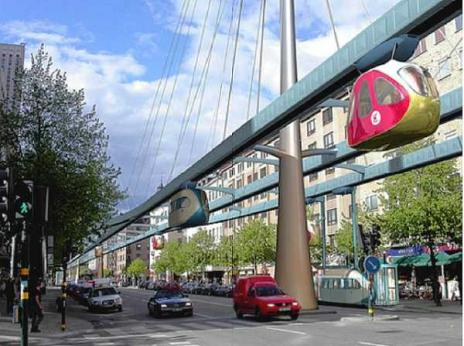
Electric pods running on rechargeable batteries have also been proposed for Masdar city. The advantages of electric pods is that they have already been implemented in many regions of the world thus making this technology more reliable as it has undergone extensive testing. The pods are expected to be able to reach a maximum of 60 km/hr and able to operate for 30 to 40 hours with a fully charged battery. Several prototypes of the pods have been designed and tested and ready to be put into service in Masdar (Smith, 2009).

Hydrogen fired power facility
A 500MW hydrogen fired facility is also in the developmental stages at Masdar. The facility is expected to supply Abu Dhabi with clean energy once it is working. This facility will work hand in hand with the carbon capture plant. The projected costs for this project amount to 7 billion American dollars and is a joint venture with BP.
This plant will be situated 250 kilometres off the Abu Dhabi coast and will be positioned next to the Shuweihat 1 electrical plant. This facility will be involved in the splitting of naturally occurring gases to form hydrogen gas and carbon dioxide gas. The carbon dioxide gas will be connected to the carbon pipelines and directed to the oil fields for injection. Carbon dioxide helps to improve the daily oil yield of the mines as it increases the internal pressure of the oil mines.
The hydrogen gas on the other hand is used as the fuel source to power an electricity generation plant that has the capacity of generating up to 500MW of electricity. The plant will reuse some of its output so as to facilitate its energy needs making the net power output of the facility to sum up to 400 MW. All the surplus energy from the plant will be supplied to the Abu Dhabi grid (Smith, 2009).
The hydrogen and carbon dioxide gases are produced by a steam reformer with an efficiency of approximately 80%. At high temperatures such as 700 to 1100 degree Celsius, steam can be made to react with natural gas that contains a methane compound to form carbon dioxide and hydrogen. This reaction occurs in two stages.
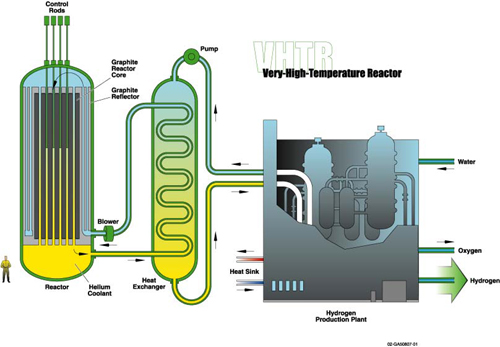
The first step of the reaction involves the reaction of methane and steam at high temperatures to form one molecule of carbon monoxide gas, three molecules of hydrogen gas and heat energy.
CH4 + H2O → CO + 3 H2 + 191.7 kJ/mol
The second reaction stage involves the reaction of carbon monoxide from the first reaction with steam at high temperatures to form one molecule of carbon dioxide gas and a molecule of hydrogen gas. However, the second stage does not produce any heat but absorbs heat produced from the initial reaction stages.
CO + H2O → CO2 + H2 – 40.4 kJ/mol
Essentially the two reaction stages are exothermic; result in heat gain. This is because the first reaction surpasses the second in heat produced. If the reformer temperatures fall below the required parameters of the reaction (700 – 1100 degree Celsius); methane gas is burnt from jets in the reformer so as to provide the required temperatures (Doeden, 2010).
A piping system is needed so as to transport the hydrogen gas from the point of production to the point where it is burnt so as to provide electricity. For hydrogen gas fibre reinforced polymers that are able to withstand up to 1000 psi are used (Tester, 2005).
EcoCommercial Building prototype
Bayer Material Science which is a subsidiary of Bayer AG has signed an agreement with the Masdar group that involves the construction of a Building prototype named EcoCommercial at Masdar city. The EcoCommercial prototype willl be a working example of sustainable energy in subtropical regions.
The building will showcase products and packages from the Bayer AG construction group. The Bayer group will also make use of the centre so as to train and create knowledge on construction activities that are conscious and mindful of the environment (Gabriel, 2008).
The ECB prototype will demonstrate how constructions can be made economical and energy efficient so as to make saving in the energy and resource requirements of construction activities. The reasons for the emphasis on clean construction methodology that the centre promotes is because construction work is responsible for forty percent of the earth’s energy expenditure and one third of the green house gases that are emitted annually (Droege, 2009).
The structural aspects of the building have also been designed according to the unique needs of Masdar. For example there has been extensive use of ‘Makrolon multi UV IQ Relax multiwall sheets’ that have good aesthetic value as well as conserve energy in the building. Below are structural and operational characteristics of the EcoCommercial building (Kibert, 2008):
- Will be constructed in an energy efficient and conservative manner
- Will be of modern designs adapted for tropical climate conditions
- The building will be used for communicative, exhibitive and training purposes
Sustainable energy research
The Masdar apart from being the apex of green energy technology will serve as a means to the advancement of green energy technology. The dream of the Masdar founders is to boost the green energy potential to exceed their current abilities (Bowden, 2009).
The Masdar Institute is a major foundation on which the possibilities of fulfilling this dream lie. One of the latest developments as a result of research is the development of concrete that requires minimal amounts of water to prepare it. The Masdar institute has several research programs that it is currently undertaking (Jones, 2009):
- The development of a compacted heat exchanger made from super plastic micro channels.
- A low lift system for cooling that is energy efficient and integrates desiccant dehumification
- A comprehensive method for assessment of solar cooling systems using location and climate data
- A method of recovering bitumen using solar technology
- The use of monolithic infrared technology in advancing chemical / gas sensor systems
- The development of a more advanced power grid and supply network
- The desalination and reclamation of water from the oceans and seas
- The generation of power sources and fuels from plant cellulose
- The study of heat transfer in nanofluids and the effects of ‘dielectrophorically assembled nanoparticles’
Material supply and supply chain
The Masdar project is true to its policies of zero carbon emission and this can be seen in their approach towards supplier relations. The Masdar suppliers are required to be partners in the drive towards zero carbon emissions and the production of green construction materials. This has been done to ensure that the Masdar is not only green in its energy expenditure but also in its founding fabrics. The Masdar authorities have come up with a distinct set of guidelines that are meant to guide its suppliers so as to ensure that their principles remain in line with those of Masdar. These are (Palmer, 2004):
- The building materials must be made from agricultural wastes or recycled industrial materials
- The processes involved in the manufacturing of the construction materials should efficiently utilize resources and cause no harm to the environment either directly or indirectly
- The building materials should also be recyclable and reclaimable at the end of their useful life
- The materials should also be useful to the environment in which they will be used
The recycling of building materials solves the problems of wastes as a result of building operations and prevents the over exploitation of virgin resources. Instead of the exploitation of virgin resources, man can still satisfy his needs by the conversion of wastes into useful materials. Such activities have a positive impact to the environment in the long run (Droege, 2009).
The use of recycled materials reduces the amount of energy that is used to produce construction materials. An example is the recycling of lead bars that shortens the lead acquisition process by avoiding mining and transportation of new deposits. Instead used lead is molten so as to provide new lead bars. As a result the total energy spent per unit of a material is greatly reduced not to mention environmental benefits (Jones, 2009).
Sourcing of raw materials has also been an important aspect for the Masdar authorities as measures have been taken so as to avoid sourcing materials from very far from the construction site. This measure has been put in place so as to avoid energy losses in the transportation processes of the building materials.
To successfully implement its principles the Masdar has appointed a team of specialists to work hand in hand with its suppliers and assist them to try and make energy savings in their activities. The team is also responsible for assessing the progress of the suppliers and their adherence to the zero carbon policies of Masdar. Recommendations on the choice of materials are also made by the teams in a genuine attempt to ensure the supplier activities do not pose harm to the environment (Masdar Website, 2010).
The Masdar supply chain team has faced many challenges in its activities but has however managed to record a few successes. A major success of the team has been to engineer the production of a 90% recycled aluminium sheet. This sheet has a very low content of embodied carbon ranging from 10.44 to 0.98 CO2/kg. These sheets were used to prepare window facades for the Masdar Institute of Technology (Palmer, 2004).
The Masdar city centre also employed the use of green aluminium. However coming up with the required aluminium for the city centre was a great challenge since stronger aluminium was needed compared to the one used for the Masdar Institute. The aluminium for the city centre was 6063; this could only be recycled from harder aluminium components such as used engines, windows and doors. Aluminium 5000 such as what was used in the Masdar Institute was recycled from old cans and requires simpler machinery and equipment. The challenge that the team faced was that the aluminium 6063 could not be recycled in the middle east and thus European companies had to be sourced. The challenge of recycling aluminium 6063 alloy is the presence of impurities such as furans, duxans, acidic compounds, organic carbon elements and dust exhaust gases that bind to the aluminium and require sophisticated machinery to separate.
The team was able to find a smelter in Europe who was able to prepare recycled aluminium using green fuel. The aluminium was shipped to the United Arab Emirates where it was extruded for use in the Masdar City Centre (Whitehead, 2009).
Two major types of aluminium are being used in the construction of Masdar city namely Aluminium 5000 and Aluminium 6063. Aluminium 6063 is harder than aluminium 5000 and is used in applications that require more strength and durability (Droege, 2009).
Aluminium 6063 is derived from used motor vehicle parts such as engines. The aluminium 6063 is smelted in European smelters and is prepared into aluminium billets. The billets are shipped to the United Arab Emirates where they are extruded to form window frame extrusions. Aluminium 5000 on the hand is derived from used cans. It is smelted and then rolled to form aluminium sheets that are 90% recycled. These sheets are then pressed to form aluminium facades that are shipped to the United Arab Emirates in finished form ready for installation (Palmer, 2004).

Discussion
The Masdar city is a practical example of green energy solutions that have been applied to a working city. The city from its designs will be able to produce more energy than it can consume and will thus have the potential of selling energy resources to the Abu Dhabi grid. From the sales of excess energy the city will be able to generate extra income for use by its municipal agency (Bowden, 2009).
The success of the city has been made possible by the genuine and sincere desires of the Masdar authorities to produce a city that will be an example to the whole world. It is owing to the enhanced network and cooperation of the Masdar authorities with the international community that will enable the project to reach out to people from all over the world. The dream of the Masdar founders is to demonstrate to people all over the world that green energy is viable and cheap to implement. The good international relations with Masdar and the involvement of international corporations has opened a leeway through which assistance and technological know how can be offered to improve the city. A major contributor to the project has been the American based Massachusetts Institute of Technology that has pledged to provide technological support to the Masdar Institute of Technology. The Masdar continues and will continue to enjoy from international support due to the fact that is had readily welcomed people from all corners of the world to participate and make the project a success (MELANGE, 2008).
The Masdar once completed will be a global hub for green / clean fuel technology. The city will be a central point in which designers, manufactures and researchers will share ideas and improve on ideas so as to facilitate the advancement of knowledge on green energy. Masdar will also attempt to commercialise green energy; this is a bold step in the promotion of clean technology as many firms and industries are hesitant to shift to massive production of green energy commodities due to lack of readily available markets and commercial viability. Masdar will also be supported by the advanced transport, communication and tourism industries of Abu Dhabi that will assist in boosting its performance (Wikipedia, 2009).
The case study of Masdar shows that green technology is relatively new and expensive to implement. The on going projects inside Masdar are proof that the initial costs for setting up clean energy systems are higher than those of conventional energy production systems. The Masdar city and its supporting structure have been expensive to construct. The reason for this is because green energy technology is relatively new and thus has not been well refined as yet. The city however has the prospects of reducing green energy prices once it is operational and further research has been facilitated (Bowden, 2009).
The project has however faced many limitations in it implementation. One difficulty that the Masdar designers faced was on how to incorporate Arab culture and religion into the city and still maintain a modern and progressive outlook. The designers had a difficult time in integrating Arabic ancient culture into the city and at the same time create trendy designs that would appeal to the present generation (Palmer, 2004).
A shortcoming of the Masdar city center is that its designs are very complex and technology intensive. It is argued that a similar aesthetic value could have been obtained without the need for too much sophistication and use of complicated systems. The application of complicated systems in new areas such as green energy is discouraged as it fosters the development of products that have not been well tested. An example is the mushrooms that are being built at the city center. The mushrooms due to their mechanical properties and frequent opening and closing are bound to breakdown due to the normal wear and tear as a result of their daily use. This would increase the maintenance cost of the city centre. Such technology is also expensive due to its complicated nature (Yudelson, 2009).
A contrasting example in Masdar where economical, aesthetic and functional green energy has been used is in the street lighting. The street lighting used in Masdar is cheap, durable and practical to the current world.
Another limitation of Masdar has been its overemphasis on green energy technology from its construction to its operation phases. Critics of Masdar say that it would have been better for the Masdar authorities to pay more attention to the green energy in the operational phase of the city. The overemphasis on clean construction has forced contractors to source for recycled building materials and thus lowering the strength and quality of the internal structure of the buildings. This is because recycled materials, even though they promote a clean environment result in construction materials of a poorer quality compare to pure ones. The choice of using recycled materials in the city’s construction will result in a less durable and formidable city structure (Kibert, 2008).
Another limitation of the Masdar project is that it is proposing a technology for a world that is not ready to implement green technology. The Masdar is a city that is way before its time. Some critics propose that the technologies used in Masdar would take more than two decades to be cost effective and affordable for practical use of in the world’s city. A separate group of critics claim that the Masdar is an unrealistic city based on the thirst of Abu Dhabi authorities to make Abu Dhabi a tourism capital; thus Masdar is more of a tourist attraction and an income generator rather than a genuine attempt to advance clean energy know how (Jones, 2009).
Clean technology is also not applicable to poor countries of the world. The reasons why poor countries cannot employ clean fuel technology is because of the lack in the technical know how and the huge initial costs that they cannot afford. It is on this basis that cities such as Masdar are a preserve for the rich nations (Droege, 2009).
Critics also claim that the United Arab Emirates, which is one of the world’s leading producers of oil, is responsible for most carbon emissions in the globe. It is therefore satirical for the United Arab Emirates to claim that it supports clean fuels. This is because if clean fuels were adopted on a global scale the UAE would lose most of its revenue from oil sales. It is based on this claims that critics further state that the Masdar is a corporate social responsibility ploy of the UAE that is impractical (Kibert, 2008).
Conclusion
The Masdar city in overall is a true representation of a modern city that has integrated clean fuel technology into its main fabric. The location of Masdar has also been of great benefits to the advancement of green technology. This is because deserts receive very high amounts of solar energy that can be effectively converted into electrical energy (Bowden, 2009).
The United Arab Emirates government has also been a great contributor to the success of the project. Were it not for the huge financial investments and good international relationships that have been harnessed to make the project a success the Masdar would have been a big failure.
The genuine attempt of the United Arab Emirates to advance green energy knowledge in the world will be of great benefit to future generations. The development of Masdar is based on the understanding that crude oil and its products are responsible for most of the world’s carbon emissions. The massive oil deposits of the United Arab Emirates have catapulted it into one of the world’s greatest economies. It is in this knowledge that the United Arab Emirates officials saw it fit to give back to the environment from which their country has very much benefited. The second motivational factor is because the world’s oil reserves are speedily running out and alternative energy sources need to be found. The Masdar is a symbol of hope to the world that shows possibilities that lie beyond oil as the major source of fuel (Kibert, 2008).
The Masdar is a sustainable city in all forms. This can be seen from its ability to be self sufficient in its energy and water usage. The abilities of the city to generate surplus electricity, harness rain water, recycle its water supply and recycle organic wastes is solid proof that sustainable cities are workable in today’s world. The Masdar city has also demonstrated the ability to produce zero carbon emissions and the possibilities of a pollution free city (Yudelson, 2009).
The Masdar has also proven that green energy does not have to be inefficient, unattractive and uncomfortable for human use but can be adapted so as to maintain man’s living standards and even improve on them. Masdar is an attractive, luxurious city that uses green energy; this is proof that green cities are sustainable and implementable in many societies. Masdar has also proven that a city could be sustainable, economical, carbon free and at the same time maintain the cultural and social values of a people (Droege, 2009).
The Masdar is a remarkable representation of a sustainable city in today’s world and serves to show that clean energy technology can truly be implemented. It is no doubt that in the not too distant future all cites of the world will be similar or closely similar to Masdar (Jones, 2009).
Referrences
Aqeel, S., 2010. Masdar City Photos – World’s First Sustainable, Zero-carbon, Zero-waste City. Web.
Bowden, R., 2009. Building Homes for Tomorrow. Chicago: Evans Brothers.
Business Wire, 2009. First Solar to Supply Modules for Masdar City Solar Power Project. Web.
Cassedy, E., 2000. Prospects for sustainable energy: a critical assessment. Cambridge: Cambridge University Press.
Cheyney, T., 2009. Masdar City’s 10-MW solar PV power plant activated. Web.
Doeden, M., 2010. Green Energy: Crucial Gains Or Economic Strains? California: Twenty-First Century Books.
Droege, P., 2009. 100% Renewable: Energy Autonomy in Action. Washington: Earthscan Publishing.
Environmental Graffiti, 2010. Masdar: The Zero Carbon, Zero Waste City of the Future. Web.
Eicker, U., 2009. Low Energy Cooling for Sustainable Buildings. New Jersey: John Wiley and Sons.
Gabriel, M., 2008. Visions for a sustainable energy future. Arizona: The Fairmont Press Inc.
GLOBE-Net, 2010. Masdar City Sustainable Concrete Competition. Web.
Green Economy Coalition, 2010. Masdar City, Abu Dhabi. Web.
Green Energy Republic, 2009. Masdar – Sustainable city. Web.
Jim on Light Blog, 2009. Masdar’s Massive Photovoltaic Array. Web.
Jones, C., 2009. Dimensions of the Sustainable City. New Jersey: Springer Publishers.
Kibert, J., 2008. Sustainable Construction: Green Building Design and Delivery. New Jersey: John Wiley and Sons.
Lechner, N., 2008. Heating, cooling, lighting: sustainable design methods for architects. New Jersey: John Wiley and Sons.
Masdar Website, 2010. Masdar Power. Web.
Masdar Capital, 2010. Masdar City Partnership Opportunities. Web.
McGrath, J., 2010. Is a zero-carbon, zero-waste, zero-car city on the horizon? Web.
MELANGE, 2008. Masdar headquarters to generate more energy then it uses. Web.
Mirchandani, V., 2010. The New Polymath: Profiles in Compound-Technology Innovations. New Jersey: John Wiley and Sons.
Oxford Business Group., 2009. The Report: Abu Dhabi 2009. Oxford: Oxford Business Group Publishers.
Palmer, P., 2004. Getting to zero waste. Portland: Purple Sky Press.
Smith, P., 2009. Building for a Changing Climate: The Challenge for Construction, Planning and Energy. New York: Earthscan.
Tester, J., 2005. Sustainable energy: choosing among options. Massachusetts: MIT press.
Tiezzi, E., 2010. The Sustainable City VI: Urban Regeneration and Sustainability. Southampton: WIT Press.
United Nations Environmental Program., 2009. Climate Action 2009/2010. Nairobi: Earthprint.
Whitehead, R., 2009. Residential Lighting: A Practical Guide to Beautiful and Sustainable Design. New Jersey: John Wiley and Sons.
Wikipedia, 2009. Masdar City. Web.
Yudelson, J., 2009. Green building trends: Europe. London: Island Press.
Yudelson, J. & Fedrizzi, S., 2008. The green building revolution. Washington: Island Press.